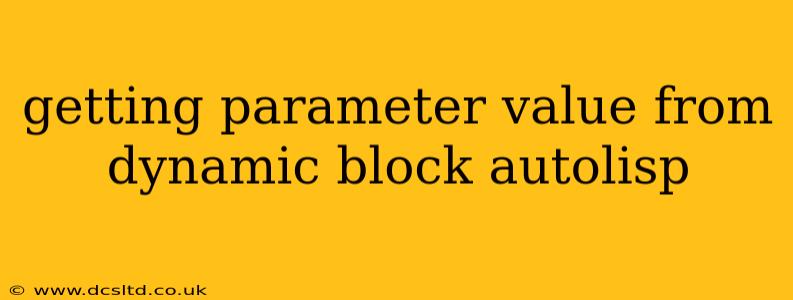Dynamic blocks in AutoCAD offer powerful customization, allowing you to create intelligent blocks with user-editable parameters. Retrieving the values of these parameters within AutoLISP is crucial for automating tasks and creating sophisticated workflows. This guide will walk you through the process, covering different approaches and addressing common challenges.
Understanding Dynamic Block Parameters
Before diving into AutoLISP code, it's essential to understand the structure of dynamic blocks and their parameters. Each parameter has a unique name and various properties, including its current value and data type. AutoLISP interacts with these parameters through the entget function, but navigating the nested lists it returns can be tricky.
Using entget to Access Parameter Values
The entget function is the cornerstone of retrieving data from AutoCAD entities, including dynamic blocks. It returns a list of entity data, and within that list lies the information about the dynamic block parameters. The key is identifying the correct sublists containing parameter data.
Here's a basic example demonstrating how to get a parameter value:
(defun c:getParameterValue (blockName parameterName / block ent)
(setq block (entget (vlax-ename->vla-object (getentity blockName))))
(setq ent (vlax-get-property block 'Parameters))
(if ent
(progn
(foreach param ent
(if (= (vlax-get-property param 'Name) parameterName)
(progn
(princ (vlax-get-property param 'Value))
(setq ent nil) ;; Exit loop once found
)
)
)
(if ent (princ "\nParameter not found"))
)
(princ "\nBlock not found")
)
(princ)
)
Explanation:
c:getParameterValue: Defines the AutoLISP function.blockNameandparameterName: These are input arguments specifying the block name and the parameter name whose value needs to be retrieved.block: Stores the result ofentget, representing the block entity data. Thevlax-ename->vla-objectconverts an entity name to a VLX object, making it easier to work with.ent: Stores the list of parameters from theParametersproperty of the dynamic block.foreachloop: Iterates through the list of parameters.vlax-get-property: Retrieves theNameandValueproperties of each parameter.- Conditional Statements: Check if the parameter name matches the input
parameterName. If found, the value is printed; otherwise, an appropriate message is displayed.
How to use it:
- Open the AutoCAD command line.
- Type
(load "your_lisp_file.lsp")(replace "your_lisp_file.lsp" with the actual file name). - Type
(c:getParameterValue "MyDynamicBlock" "MyParameter")(replace with your block and parameter names).
Handling Different Parameter Types
Dynamic blocks support various parameter types (e.g., numerical, textual, point). The above example handles simple values. For more complex types like points or lists, you might need to adjust how you access and process the Value property. Consider using vlax-get-property to access specific sub-properties depending on the parameter type.
How to Get the Values of Multiple Parameters
To efficiently retrieve multiple parameter values, modify the function to accept a list of parameter names and return a list of corresponding values. This avoids repeated calls to entget.
(defun c:getParameters (blockName paramList / block ent params)
(setq block (vlax-ename->vla-object (getentity blockName)))
(setq ent (vlax-get-property block 'Parameters))
(setq params nil)
(if ent
(progn
(foreach pName paramList
(foreach param ent
(if (= (vlax-get-property param 'Name) pName)
(progn
(setq params (append params (list (vlax-get-property param 'Value))))
(setq param nil) ;;Exit inner loop
)
)
)
)
params
)
(princ "\nBlock not found")
)
)
This function takes a list of parameter names (paramList) and returns a list of their corresponding values.
Error Handling and Robustness
Always include robust error handling. Check for the existence of the block and parameters before attempting to access their properties. Handle potential errors gracefully, providing informative messages to the user.
Conclusion
Retrieving parameter values from dynamic blocks in AutoLISP empowers you to create powerful automation scripts and add advanced functionality to your AutoCAD drawings. This guide provides a strong foundation for working with dynamic block parameters, offering examples and best practices for handling different situations. Remember to adapt the code to handle various parameter types and always include comprehensive error handling for a robust and user-friendly solution.
